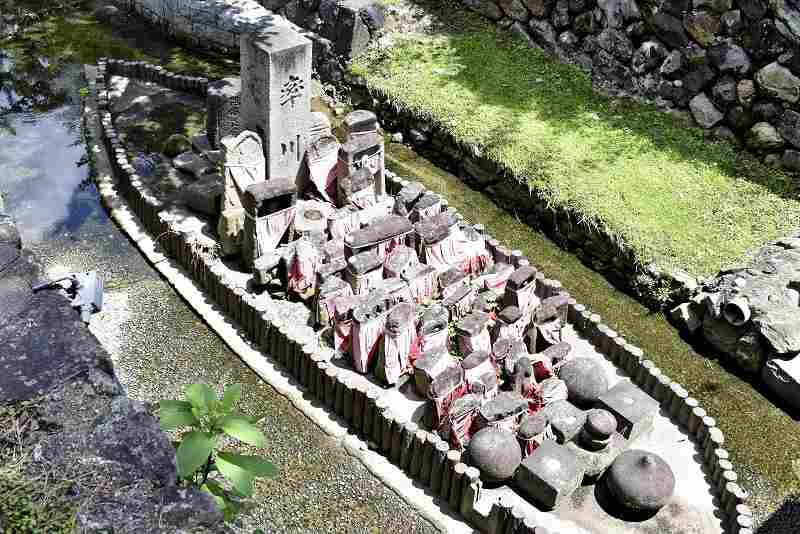
Jizo statues stand on a “boat” fashioned from stone in a river in Nara City.
17:45 JST, October 9, 2021
NARA — Dozens of small stone statues set on a rock foundation fashioned in the shape of a boat in a river near Nara City’s scenic Sarusawa Pond have become a popular attraction among social media users.
Known as Isagawa Jizoson, the tableau features about 60 jizo — a guardian deity of children — outfitted with red bibs standing side by side, giving passersby reason to pause and wonder when they were placed there and why.
“I’ve never seen anything like it before,” a tourist wrote in a post on Twitter that included a photograph. The tweet quickly went viral, garnering 20,000 likes. Replies poured in, with one user writing “Is that supposed to be the Sanzu River?” in a reference to the Buddhist equivalent of the River Styx. “Fantastic” added another, and “It’s a treasure ship bearing ojizo-san.”
Isagawa Jizoson is located on the Isagawa river that flows just south of Sarusawa Pond. The river has a long, distinguished history and is even cited in the Manyoshu, the oldest anthology of Japanese poems.
Looking down from a small stone bridge traversing the river, tourists can see that some of the statues’ heads and faces are gone. But the red bibs on every jizo seem relatively new.
The tableau captures the attention of tourists and students on school trips when they cross the bridge.
“I came here after the photo went viral on social media,” said a 33-year-old woman from Uji, Kyoto Prefecture. “The scenery looks like the Bon Festival’s floating lanterns carrying the spirits of the dead.”
However, the origin of Isagawa Jizoson is unknown.
“It isn’t designated as a cultural property, so no detailed records exist,” said an official from the cultural properties division of the Nara board of education.
But all is not lost.
“Statues are unearthed from the bottom of the river every time improvement work is done on the waterway,” said Naokazu Kano, 71, chairman of the local Imamikadocho residents association. “They are enshrined when they are found, so their number keeps increasing.”
Kano said the number of statues has doubled since there were 30 of them 40 years ago and speculates they were dumped in the river during the anti-Buddhist movement in the Meiji era (1868-1912). The figures used to be left lying in the river, and people called them “underwater jizo.”
At some point, they began to be placed on a boat-shaped foundation, although Kano doesn’t know when that practice started.
The Imamikadocho residents take good care of the jizo. The bibs are handmade and replaced with new ones every August and December. When the river rises and topples a statue, residents clean it and set it upright.
“It’s an ordinary sight for us, so it’s surprising that they are popular on social media,” Kano said. “We’ll keep cherishing the statues as they are guardians of the community.”
— The Isagawa river
The small river is 3.8 kilometers long and about 2 meters wide while most of it is comprised of underground waterways. It flows from the Mt. Kasuga Primeval Forest, passing through Tobihino grass field in Nara Park, Naramachi (Nara old town), then to the south of JR Nara Station, and eventually joins the Saho River. It is also called the Bodai River. The river appears above ground for about 200 meters on the south side of Sarusawa Pond.

A map of the ‘Isagawa Jizoson’ in Nara City, Nara Prefecture, Japan.
"Society" POPULAR ARTICLE
-

M4.9 Earthquake Hits Tokyo, Neighboring Prefectures
-

Israeli Tourists Refused Accommodation at Hotel in Japan’s Nagano Pref., Prompting Protest by Israeli Embassy and Probe by Prefecture
-

M7.5 Earthquake Hits Northern Japan; Tsunami Waves Observed in Hokkaido, Aomori and Iwate Prefectures
-

Tsukiji Market Urges Tourists to Avoid Visiting in Year-End
-

M5.7 Earthquake Hits Japan’s Kumamoto Pref., Measuring Upper 5 Intensity, No Tsunami Expected
JN ACCESS RANKING
-

Tokyo Economic Security Forum to Hold Inaugural Meeting Amid Tense Global Environment
-

Keidanren Chairman Yoshinobu Tsutsui Visits Kashiwazaki-Kariwa Nuclear Power Plant; Inspects New Emergency Safety System
-

Imports of Rare Earths from China Facing Delays, May Be Caused by Deterioration of Japan-China Relations
-

University of Tokyo Professor Discusses Japanese Economic Security in Interview Ahead of Forum
-

Japan Pulls out of Vietnam Nuclear Project, Complicating Hanoi’s Power Plans






















